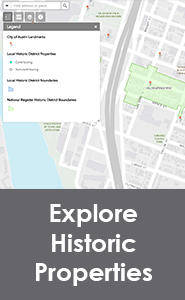Austin has more than 600 historic landmarks, 8 historic districts at the local level, and 18 National Register historic districts. The Historic Landmark Commission reviews proposed changes to these resources, as well as demolitions and relocations of 45+ year-old buildings that may be eligible for landmark designation. Explore Austin’s historic resources in the Historic Properties Viewer below.
Historic properties viewer |
Historic landmarks
Austin’s historic landmarks tell the story of the city’s growth: overall, within different communities, and with individual movers and shakers. To be eligible for landmark designation, a building must be 50+ years old, retain historic integrity, and meet two of five criteria for significance: architecture; associations with important people, groups, or events; archaeology; community value; or landscape feature. Find individual historic landmarks on the Historic Properties Viewer, or see the historic zoning application (PDF) for general information.
Historic districts
Locally designated historic districts offer the strongest protection and greatest benefit for older neighborhoods. Designation involves adding an HD to the base zoning and requires the support of a majority of property owners or land area owners, as well as high architectural integrity. Check out Historic Districts for information on specific districts.
If you’re interested in historic district designation for your neighborhood, see the historic district application guide (PDF) and application form (PDF).
National Register districts
National Register districts represent areas associated with significant events or people, or that embody distinctive architecture. These districts are designated via state and National Park Service coordination and are largely honorific; no zoning change is involved, and historic review is advisory only. The historic properties viewer shows district boundaries.
Historic resource surveys
Surveys highlight potential landmarks and historic districts by identifying older buildings and areas that help to tell the story of an important person, community, group, or the city as a whole; or exhibit significant architecture or landscape design. Surveys look at what exists on the ground through fieldwork and find out the stories behind places through research. Being included in a survey does not automatically lead to historic designation for a building or neighborhood. See Historic Resources Surveys for more information on recent survey projects.
Research older buildings and neighborhoods
Austin and its communities have a rich, textured history. The Citywide Historic Context provides an overview of how Austin developed, and the East Austin Historic Context digs into the history of East Austin. The Research Guide (PDF) explains how to do your own research on individual buildings. After reading the Research Guide, these websites are a good place to start:
- Digital Sanborn Maps (available at any computer with Austin library card)
- Ancestry (available at Austin library computers)
- Austin American-Statesman (historical, 1871-1978) (available at any computer with Austin library card)
- Austin American-Statesman (1989-present) (available at any computer with Austin library card)

